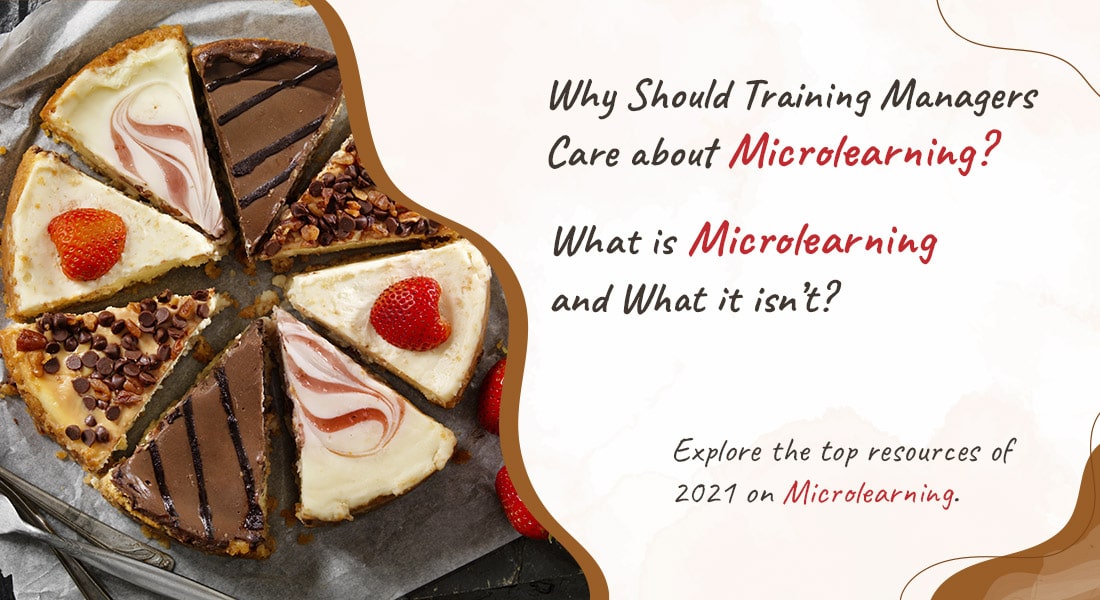Top 6 Tips for Effective Microlearning Design
Need some pointers on how to create successful microlearning? With this blog's microlearning design tips, you'll get it right the first time, every time.

Training desk-less workers is an issue that training managers encounter across enterprises. Employees that are always on the go, such as sales reps, field specialists, drivers, or warehouse staff who operate in rotations and who do not have access to PCs or laptops, fall into this category. This is a group of workers who may not be able to devote a significant amount of time to complete extensive training programs. This problem can be solved by developing microlearning solutions. Microlearning design, like a comprehensive eLearning course, takes significant thinking and planning.
It’s a proven truth that people like to learn in little portions, and this is true of online training as well! Do you, however, know how to design successful bite-sized microlearning? Let’s Explore 6 effective tips for designing microlearning.
Looking for Guidelines to Design Microlearning?
6 Wise Tips for Effective Design:
- Identify and Address a Single Performance-based Goal
- Make Use of Existing Content
- Adhere to the Minimalist Design Style
- Make Learning Bites That Are Both Short and Useful
- Make Use of a Wide Range of Learning Formats
- Stick to a Mobile-First Design Strategy
Top 6 Tips for Effective Microlearning Design
1. Identify and Address a Single Performance-based Goal
We all know that learning must be accompanied by goals. Adults, unlike kids, must clearly understand why they are learning something, according to adult learning principles. As a result, corporate training eLearning courses are not created at random. Rather, they’re built on learning objectives that are dependent on performance. When necessary, each one of these objectives allows the learner to acquire a specialized skill set or information about products or services.
This helps:
- Deliver targeted and focused information
- Avoid information overload
- Fight the forgetting curve
2. Make Use of Existing Content
Microlearning content is frequently derived from current classroom training materials or larger eLearning courses. For microlearning content production, you can use current training content such as:
- PPTs
- PDFs
- Assessment questions
- Manuals
This helps:
- Cut down effort on content development
- Save time and money in designing microlearning
Download this webinar recording to get answers to all of your microlearning queries.
3. Adhere to the Minimalist Design Style
If it isn’t easy, it isn’t microlearning. Keep in mind that the purpose of microlearning is to offer learners immediate and urgent instruction or training assistance —to help them absorb, recall, and apply information rather than forget it. The learner will become distracted and unable to focus on the key topic if a microlearning course is cluttered with extraneous images and repetitive content. Stick to the essentials: precise information and eye-catching images.
This helps:
- Learners assimilate information quickly
- Improve the effectiveness of microlearning
4. Make Learning Bites That Are Both Short and Useful
Microlearning, as you may be aware, is presented in the form of little learning nuggets that learners may readily absorb. Microlearning design, on the other hand, isn’t only about brief material. You must also consider the content’s utility. Find content that can assist learners in completing a task, making decisions, or taking action.
This helps:
- Easy consumption of learning nuggets
- Learners focus on the usefulness of the content
5. Make Use of a Wide Range of Learning Formats
The utilization of a range of formats to complement the learning experience is one of the greatest aspects of microlearning design. To keep learners interested in the learning process, mix and match different microlearning formats. Select the microlearning format or material based on the goal.
This helps:
- Quick information transfer
- Effective introductions to concepts/processes
- Reinforce learning
6. Stick to a Mobile-First Design Strategy
According to Forbes, 80% of the world’s workforce works without a desk; not only as a result of greater technical proficiency and dependency but also as a result of the ongoing worldwide COVID-19 epidemic. Making training accessible to your learners via mobile devices guarantees that those who work at their speed, in their place, and at their own pace are not left out of the learning process. That’s why it is better to approach microlearning from a mobile-first perspective.
This helps when learners:
- Use multiple mobile devices
- Prefer learning on-the-go
- Need access to quick performance support solutions
Parting Thoughts
Gone are the days of laborious manuals and dreary textbooks. The twenty-first century is all about being short and snappy. So why not take advantage of it? If microlearning isn’t currently a part of your training plan, it’s time to start thinking about how to create microlearning solutions. “Where Does Microlearning Fit in Your Learning Strategy?” is a free eBook to download. An introduction to microlearning design can be found in this How-to Guide.





